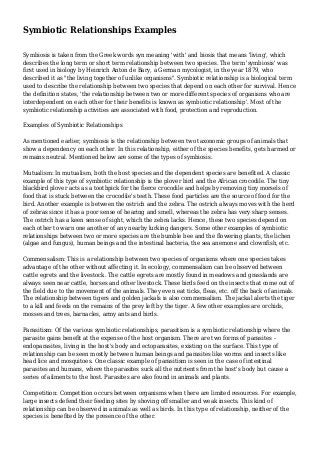Symbiotic Relationships Examples
•
1 like•855 views
Symbiosis is taken from the Greek words syn meaning 'with' and biosis that means 'living', which des...
Report
Share
Report
Share
Download to read offline

Recommended
Recommended
More Related Content
Featured
Featured (20)
How Race, Age and Gender Shape Attitudes Towards Mental Health

How Race, Age and Gender Shape Attitudes Towards Mental Health
AI Trends in Creative Operations 2024 by Artwork Flow.pdf

AI Trends in Creative Operations 2024 by Artwork Flow.pdf
Content Methodology: A Best Practices Report (Webinar)

Content Methodology: A Best Practices Report (Webinar)
How to Prepare For a Successful Job Search for 2024

How to Prepare For a Successful Job Search for 2024
Social Media Marketing Trends 2024 // The Global Indie Insights

Social Media Marketing Trends 2024 // The Global Indie Insights
Trends In Paid Search: Navigating The Digital Landscape In 2024

Trends In Paid Search: Navigating The Digital Landscape In 2024
5 Public speaking tips from TED - Visualized summary

5 Public speaking tips from TED - Visualized summary
Google's Just Not That Into You: Understanding Core Updates & Search Intent

Google's Just Not That Into You: Understanding Core Updates & Search Intent
The six step guide to practical project management

The six step guide to practical project management
Beginners Guide to TikTok for Search - Rachel Pearson - We are Tilt __ Bright...

Beginners Guide to TikTok for Search - Rachel Pearson - We are Tilt __ Bright...
Unlocking the Power of ChatGPT and AI in Testing - A Real-World Look, present...

Unlocking the Power of ChatGPT and AI in Testing - A Real-World Look, present...
Symbiotic Relationships Examples
- 1. Symbiotic Relationships Examples Symbiosis is taken from the Greek words syn meaning 'with' and biosis that means 'living', which describes the long term or short term relationship between two species. The term 'symbiosis' was first used in biology by Heinrich Anton de Bary, a German mycologist, in the year 1879, who described it as "the living together of unlike organisms". Symbiotic relationship is a biological term used to describe the relationship between two species that depend on each other for survival. Hence the definition states, 'the relationship between two or more different species of organisms who are interdependent on each other for their benefits is known as symbiotic relationship'. Most of the symbiotic relationship activities are associated with food, protection and reproduction. Examples of Symbiotic Relationships As mentioned earlier, symbiosis is the relationship between two taxonomic groups of animals that show a dependency on each other. In this relationship, either of the species benefits, gets harmed or remains neutral. Mentioned below are some of the types of symbiosis. Mutualism: In mutualism, both the host species and the dependent species are benefited. A classic example of this type of symbiotic relationship is the plover bird and the African crocodile. The tiny blackbird plover acts as a toothpick for the fierce crocodile and helps by removing tiny morsels of food that is stuck between the crocodile's teeth. These food particles are the source of food for the bird. Another example is between the ostrich and the zebra. The ostrich always moves with the herd of zebras since it has a poor sense of hearing and smell, whereas the zebra has very sharp senses. The ostrich has a keen sense of sight, which the zebra lacks. Hence, these two species depend on each other to warn one another of any nearby lurking dangers. Some other examples of symbiotic relationships between two or more species are the bumble bee and the flowering plants, the lichen (algae and fungus), human beings and the intestinal bacteria, the sea anemone and clownfish, etc. Commensalism: This is a relationship between two species of organisms where one species takes advantage of the other without affecting it. In ecology, commensalism can be observed between cattle egrets and the livestock. The cattle egrets are mostly found in meadows and grasslands are always seen near cattle, horses and other livestock. These birds feed on the insects that come out of the field due to the movement of the animals. They even eat ticks, fleas, etc. off the back of animals. The relationship between tigers and golden jackals is also commensalism. The jackal alerts the tiger to a kill and feeds on the remains of the prey left by the tiger. A few other examples are orchids, mosses and trees, barnacles, army ants and birds. Parasitism: Of the various symbiotic relationships, parasitism is a symbiotic relationship where the parasite gains benefit at the expense of the host organism. There are two forms of parasites - endoparasites, living in the host's body and ectoparasites, existing on the surface. This type of relationship can be seen mostly between human beings and parasites like worms and insects like head lice and mosquitoes. One classic example of parasitism is seen in the case of intestinal parasites and humans, where the parasites suck all the nutrients from the host's body but cause a series of ailments to the host. Parasites are also found in animals and plants. Competition: Competition occurs between organisms when there are limited resources. For example, large insects defend their feeding sites by shoving off smaller and weak insects. This kind of relationship can be observed in animals as well as birds. In this type of relationship, neither of the species is benefited by the presence of the other.
- 2. Neutralism: In this relationship both the species remain unaffected. The species may be living side by side but are unaware of each other and also cause no harm to each other. This is commonly seen in various plant species that grow side by side in forests. These were some examples of symbiosis in nature. If we observe the surroundings near us we will come across many instances of this survival method. However, it is almost a law of nature that two species have to depend on each other for mutual advantage and existence. http://www.buzzle.com/articles/symbiotic-relationships-examples.html